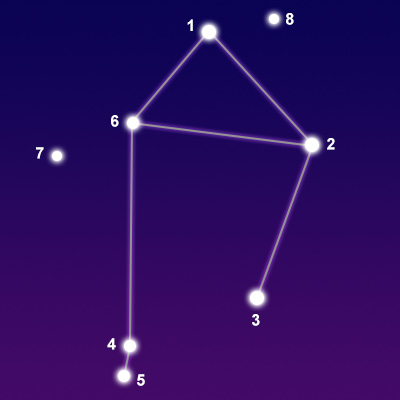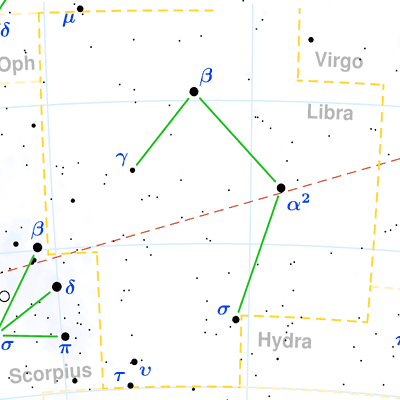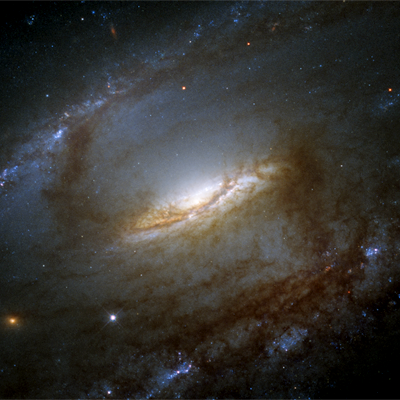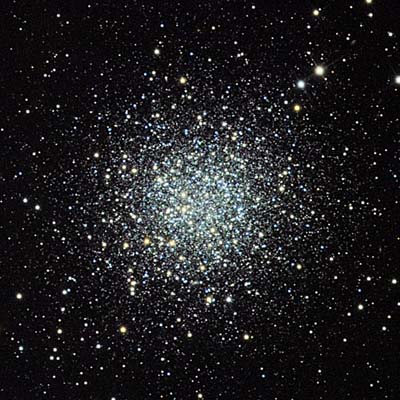Pronunciation:
(LEE-bruh)Abbreviation:
LibGenitive:
LibraeRight Ascension:
15 hoursDeclination:
-15 degreesArea in Square Degrees:
538Crosses Meridian:
9 PM, June 20Visible Between Latitudes:
65 and -90 degreesThe constellation Libra, the scales, is visible at latitudes between 65 degrees and -90 degrees. It is a medium-sized constellation occupying an area of 538 square degrees. It ranks 29th in size among the 88 constellations in the night sky. It is bordered by the head of Serpens to the north, Virgo to the northwest, Hydra to the southwest, the corner of Centaurus to the southwest, Lupus to the south, Scorpius to the east and Ophiuchus to the northeast. It is one of the thirteen constellations of the zodiac. This means it lies along the path the Sun travels in the sky during the year. It is the only constellation of the zodiac that represents an object instead of an animal or a person from mythology.
Libra is one of the 48 constellations first cataloged by the Greek astronomer Ptolemy in the second century. Its name means “the weighing scales” in Latin. It is usually depicted as the scales held by the Greek goddess of justice Astrea, which is represented by the neighboring constellation Virgo. Virgo is an ancient constellation with its roots in many early cultures. The ancient Babylonians saw it as the Balance of Heaven. In ancient Greece, it represented the claws of the scorpion, and was considered to be part of the constellation Scorpius. In ancient Egypt the three brightest stars formed a constellation that was viewed as a boat. To the early Romans, it was the golden chariot of Pluto, god of the Underworld. It eventually came to be associated with the scales. Today it is seen as a universal symbol of balance, harmony, and justice.

points of interest below © Sea and Sky

© Torsten Bronger CC BY-SA 3.0
Zuben Elgenubi
Brachium
Upsilon Librae
Tau Librae
Zuben Elakrab
Theta Librae
Zuben Elakribi
"Southern Scorpion Claw"
"Arm"
N/A
N/A
"Shears of the Scorpion"
N/A
"Claws of the Scorpion"
Multiple Star System
Red Giant Star
Orange Giant Star
Blue-White Dwarf Star
Orange Giant Star
Orange Giant Star
Blue-White Dwarf Star
2.75
3.29
3.60
3.66
3.91
4.14
4.43
Libra contains only two stars brighter than magnitude 3. The brightest star in the constellation is Zuben Elschemali with a visual magnitude of 2.61. It is a blue-white dwarf star that lies 185 light years from Earth. The second brightest star is Zuben Elgenubi with a magnitude of 2.75. It is a multiple star system located approximately 76 light years away. Brachium is the third brightest star with a magnitude of 3.29. It is a red giant star that is about 288 light years distant.
Libra contains no Messier objects but it does contain a few dim deep-sky objects. These include a barred spiral galaxy known as NGC 5792, a lenticular galaxy known as NGC 5890, and a globular star cluster called NGC 5897. These objects are extremely dim and can only be seen in large telescopes.

© Judy Schmidt from USA / CC BY 2.0

© San Esteban / CC BY 3.0



